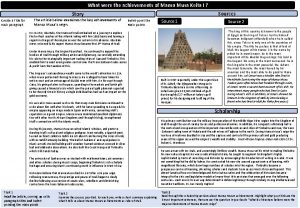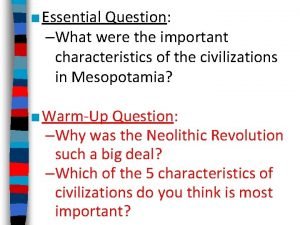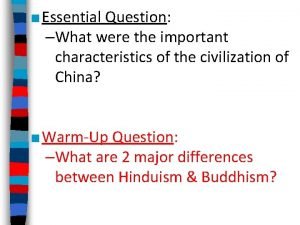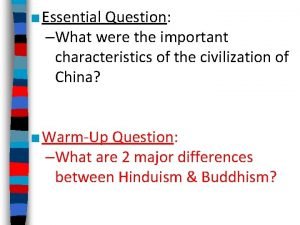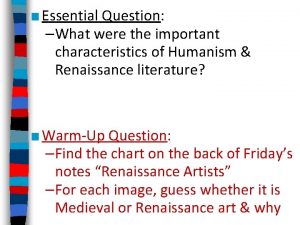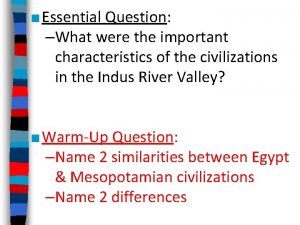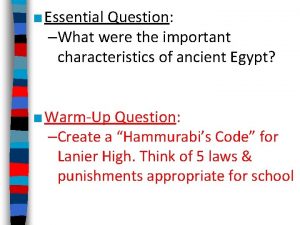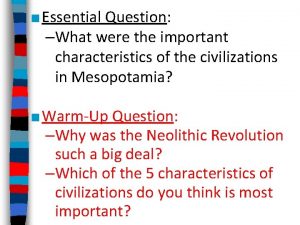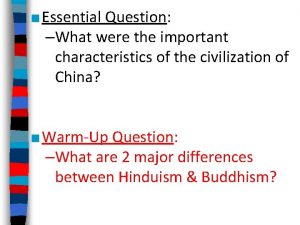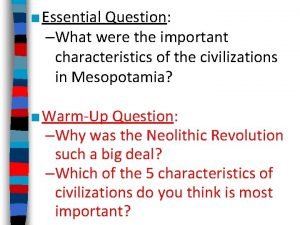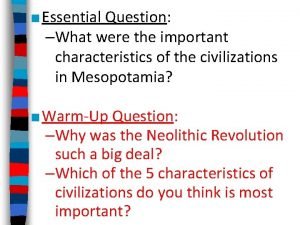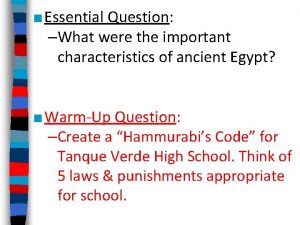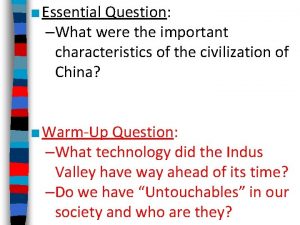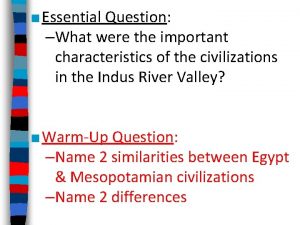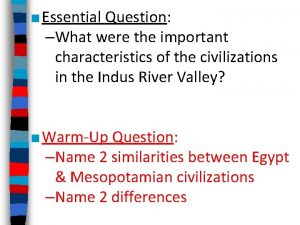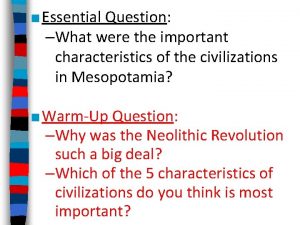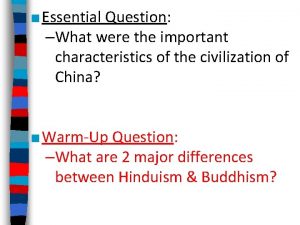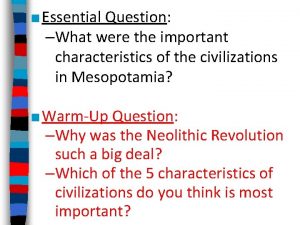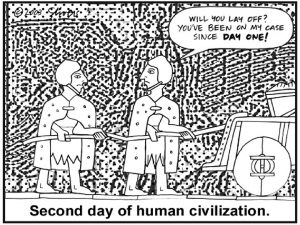Essential Question What were the important characteristics of

































- Slides: 33

■ Essential Question: –What were the important characteristics of the civilizations in Mesopotamia? ■ Warm-Up Question: –Why was the Neolithic Revolution such a big deal? –Which of the 5 characteristics of civilizations do you think is most important?

What Is Prehistory? Prehistory is everything that happened before written records. Writing developed in different places at different times. This means that, technically, the dates for prehistory vary around the world. Historians using the term prehistory are generally referring to time before the very first human writing, about 5, 000 years ago (circa 3000 BCE).

The Stone Age Old Stone Age • • • Paleolithic Age 2, 500, 000 to 8000 BCE Made stone chopping tools Hunter-gatherers Humans migrated across the globe • End of the Paleolithic coincided with the end of the last ice age • Modern human beings overlapped with Homo erectus and Neanderthals • Cave paintings and small carvings New Stone Age • Neolithic Age • 8000 -3000 BCE • Humans made numerous tools, as well as jewelry, from bone, wood, stone, tusks, etc. • Pottery • Permanent settlements • Agriculture (farming) • Animal domestication • Modern human beings left as the only hominids on the planet

River Valley Civilizations The discovery of farming during the Neolithic Revolution allowed nomadic people to settle into civilizations

The world’s first civilizations all began in river valleys The first civilization began in an area known as Mesopotamia

Mesopotamia means “land between the rivers” & is often called the “Fertile Crescent” or as the “Cradle of Civilization” The Tigris and Euphrates Rivers flooded once per year, leaving behind fertile soil ideal for farming

The first civilization developed in the Fertile Crescent: Sumer But, surrounding deserts & the lack of natural barriers attracted outsiders to Mesopotamia made the Sumerians vulnerable to attack

The Middle East: “The Crossroads of Three Continents” ■ The Middle East is called the crossroads because three continents of Europe, Asia, and Africa come together here

Lasting Contributions ■ Advanced cities: – Sumerian city-states were protected by high walls – At the city center was a temple called a ziggurat

Religion and Afterlife ■ Sumerians practiced polytheistic and their gods were thought to control every aspect of life. ■ Each city built a ziggurat, a pyramid-temple that soared toward the heavens. At the top was a shrine to the chief god or goddess of the city.

Religion ■ The Sumerians believed in an afterlife, but thought the underworld was a grim place of no release. They buried food and tools with their dead. ■ Unlike the Egyptians, they did not imagine the afterlife in detail. ■ They did not believe in rewards and punishments.

Lasting Contributions Specialized Workers: – At the top of society were priests, and then kings – In the middle were skilled workers, like merchants - At the bottom, were commoners, slaves, etc.

Lasting Contributions Religion: The Sumerians believed in polytheism, or many gods. Each god had power over different forces of nature or parts of their lives. Sumerians believed that people were just the servants of the gods

Lasting Contributions ■ Writing: – Sumerians made the world’s 1 st writing called cuneiform – Phoenicians simplified cuneiform to a 22 letter alphabet – Phoenician merchants spread the alphabet throughout the Mediterranean world – The alphabet influenced Greek, Latin, & English

Gilgamesh Epic Tablet: Flood Story ■ The Story of Gilgamesh is similar in that it includes a tale of a global flood to punish man for his wrongdoings. Sound familiar?

Lasting Contributions ■ Technology: – Sumerians inventions include the wheel, sail, plow, & bronze metalwork

Akkadians ■ Sargon, King of Akkad, conquered the city-states (2300 B. C. ) and built an empire. ■ After his death, other invaders swept into the wide valley tumbling his empire into ruin ■ Akkad were Semitic people, like the Hebrews

Babylon - “Gate of God” The Sumerians were conquered by the Babylonians. The king of Babylon was Hammurabi united the cities of Sumer and then expanded his empire all the way to Asia Minor

The Babylonians ■ A Semitic people who spoke Akkadian, conquered Mesopotamia in about 2000 B. C. Its capital, Babylon, was on the Euphrates River ■ The king of Babylon, Hammurabi, brought the empire (much of Mesopotamia) under his control and established the first written laws, criminal and civil.

A Crossroads of Trade Babylon’s location made it a good place for trade. Groups of travelers, called caravans, traveled back and forth from the Sumerian cities in the south to the city of Akkad in the north. Along the way, they always stopped in Babylon to trade. Babylon had special markets, called bazaars, that people could go to to buy cotton cloth from India. They could also buy spices from Egypt there. Babylon became rich due to trade.

Lasting Contributions ■ Government: – Babylonian King Hammurabi created the first legal code – Hammurabi’s Code had 282 laws based on justice & retaliation (an eye for an eye) – The code had different punishments for the various levels of society

Lasting Contributions

Babylonia is Conquered Hammurabi conquered many of the neighboring cities, and he kept expanding his empire. Hammurabi would often go to war against his allies as well. When the city of Elam attacked Larsa, Hammurabi helped Larsa defend themselves. Once Elam was conquered, Hammurabi turned right around and conquered Larsa! Each time that Babylon would conquer another city, Hammurabi would take the city’s chariots, weapons, tools, and all their riches. Trading helped Babylon get rich, and so did conquest. Though Hammurabi formed a large and rich empire, the people that ruled after him could not keep it together. The empire kept getting smaller and smaller until eventually it was destroyed.

Hittites The Babylonian empire fell to Hittite invaders ■ Hitties were warlike people ■ Invaded sometime in the 1600 B. C. ■ Learned to extract iron ore and had a monopoly on the resource

The Assyrians Rise to Power Assyria was a small kingdom of walled cities that was located north of Babylon. Their city was located in open land that was easily attacked, and they had to constantly defend themselves against invaders. Therefore, they became skilled warriors. At around 1365 B. C. , the Assyrians decided that the best defense they had was to attack other countries first, before they could attack them. By 650 B. C. , Assyria had conquered a large empire. King Sargon II was a successful and ruthless Assyrian ruler.

The Assyrian War Machine The Assyrians were geniuses at waging war. They invented the battering ram, which they used to pound down city walls. They used catapults to throw rocks at enemies, and the protected their archers (people who use a bow and arrows) with helmets and armor.

Assyrian Learning The capital of the Assyrian Empire was a city called Nineveh became a great city of learning. It had a famous library that held thousands of clay tablets with writings from Sumer and Babylon. These records tell us a lot about life in Mesopotamia.

The Assyrians ■ Warlike people from northern Mesopotamia, the Assyrians began to consolidate a great empire ■ For 500 years, they earned a reputation for being among the most feared warriors in history ■ After Assurbanipal’s death, people joined forces to destroy the Assyrian armies.

Assyria Overthrown The people that the Assyrians conquered were constantly rebelling against Assyrian rule. Most of the time, the Assyrians crushed the people who tried to fight them. However, in 612 B. C. , two groups joined together to smash the Assyrian empire. These groups were the Medes and the Chaldeans.

The New Babylonian Empire The Chaldeans created a new empire, centered at Babylon after they defeated the Assyrians in 612 BC. The greatest king of Babylon was Nebuchadnezzar II. He rebuilt Babylon and put massive walls around the city to protect it. He also built a great palace with hanging gardens.

A New Center for Learning Under the Chaldeans, the New Babylonian empire became a center of learning and science. Chaldean astronomers charted stars and measured the correct length of the year. Chaldean farmers raised bees for their honey. Many people came to Babylon to share ideas and discoveries. This clay tablet shows the world that was known to the Babylonians

The Fall of the 2 nd Babylonian Empire The second Babylonian empire came under attack and was defeated by the Persians, who were led by Cyrus, in 539 BC. Though the Chaldeans were defeated, the city of Babylon was spared from destruction.

The Persian Empire ■ In 539 B. C. Babylon fell to the Persian armies of Cyrus the Great. In general, Persian kings pursued a policy of tolerance. ■ Darius unified the Persian Empire in 522. He adapted laws from the people he conquered. ■ He had hundreds of miles of road built or repaired ■ He set up a common set of weights and measures and encouraged the use of coins
 Costas levels of questions
Costas levels of questions Characteristics of lipids
Characteristics of lipids Example of a news story
Example of a news story Inverted pyramid in news writing
Inverted pyramid in news writing Least important to most important
Least important to most important Figurative language essential questions
Figurative language essential questions Formula hipotenusa triangle rectangle
Formula hipotenusa triangle rectangle Essential question generator
Essential question generator Essential questions for pythagorean theorem
Essential questions for pythagorean theorem Essential questions for figurative language
Essential questions for figurative language Individual vs. society
Individual vs. society Essential questions for context clues
Essential questions for context clues Cornell notes essential question
Cornell notes essential question What if questions to ask
What if questions to ask Essential question for multiplication
Essential question for multiplication Essential question gif
Essential question gif Objective traits
Objective traits The cornell way
The cornell way Essential questions about fear
Essential questions about fear What were mansa musa's most important achievements
What were mansa musa's most important achievements What city became the center of hellenistic greek culture?
What city became the center of hellenistic greek culture? Disjunctive questions
Disjunctive questions Kasanayang pampagkatuto mula sa melcs
Kasanayang pampagkatuto mula sa melcs Future in the past simple
Future in the past simple Present simple question words
Present simple question words Moderately open question
Moderately open question Remarks adalah
Remarks adalah Factor isolating
Factor isolating Direct question vs indirect question
Direct question vs indirect question Example of compelling question
Example of compelling question Compelling question example
Compelling question example Hát kết hợp bộ gõ cơ thể
Hát kết hợp bộ gõ cơ thể Ng-html
Ng-html Bổ thể
Bổ thể



















